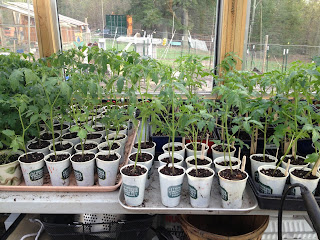I took soil samples a few weeks ago and sent them to Logan Labs. The report said that we are really lacking some phosphorus and potassium in the garden. We also need to add some lime to raise the calcium & magnesium levels, especially in the areas that have not been used as a garden before. I highly recommend soil testing every year. After reading the book, "The Intelligent Gardener", I have really come to appreciate soil chemistry and biology. Unfortunately, adding compost and more compost doesn't work like they claim in many other organic gardening books. You can not just guess what your plants may need, you have to test the soil, provide the right pH range, and add nutrients in most cases. The test costs $20 and directions on sampling can be found at
loganlabs.com We started working some of the vegetable beds in the garden with a cultivator. Based on the results of the soil test, I calculated how much fertilizer I needed to add to those areas. I also added some azomite and composted manure. We borrowed a tractor and tilled another vegetable bed below the main bed and greenhouse area. I plan to use that area to plant most of the squash and melons since they take up so much room. The lettuce, spinach, broccoli, brussel sprouts, arugula, onions, garlic, potatoes and herbs have all been planted outside now. I am in the process of transplanting all the tomatoes to bigger pots because they are already too big for the trays. I will keep them in the greenhouse until mid-May, in case we have another late frost. I have started my cucumbers, corn, squash and melons in the greenhouse. We are experimenting with growing potatoes in towers this year. I created these out of some left over metal fencing, straw, garden soil and compost. You fill the bottom with a couple inches of straw, 5 inches of dirt and compost on top of that and then plant the potatoes. You can keep layering like that until you reach the top. You will need to add straw around the sides of the bin to keep the dirt inside. There are several different ways I have seen this done online including in garbage cans but I liked the way this design provides air circulation, drainage and light to the plants. I have been making my own potting soil. I use a mix of peatmoss, compost and a bag of garden soil. Then I add a little vermiculite. It is much cheaper than buying bags of potting soil. We are getting about 5-6 dozen eggs a week from the chickens. The new chicks are getting bigger and are now in the pen with the big chickens. They are fenced off from the bigger chickens but they can still all see and hear each other. I am hoping it will help them adapt to each other before they all are together so that the bigger chicks do not kill or hurt the little ones.







